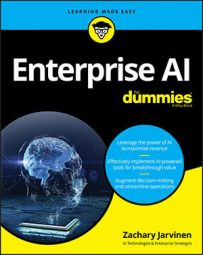But first, let’s get the burning question out of the way. Flying cars? No. Or, at least not ones that look like those in Back to the Future. Autonomous cars? They’re already here. Now, on to real stuff.
 © Pavel Chagochkin/Shutterstock.com
© Pavel Chagochkin/Shutterstock.comConsider this timeline:
- In the late eighteenth century, the steam engine powered the first industrial revolution.
- One hundred and twenty years later, at the turn of the twentieth century, commercially available electricity sparked the second industrial revolution.
- Sixty years after that, the first silicon-based computer triggered the third industrial revolution.
- Thirty years later in 1991, the World Wide Web became publicly available, laying the foundation for big data — along with computing and storage — primary drivers of the fourth industrial revolution.
Do you think that back in 1989, Tim Berners-Lee, who kicked off the World Wide Web by posting a description of the project in the alt.hypertext newsgroup, had an inkling that with the click of a mouse he had laid the foundation for the longest AI renaissance, a renaissance that has no end in sight?
Proliferation of AI in the enterprise
Information will rule the future, and AI will continue to be leveraged to process that information to solve complex challenges. Today’s limits in AI will continue to be surpassed, and applications will double across a broad range of industries.In retail, you’ll see AI maximize cross-selling by providing hyper-personalizing content through intelligent recommendations, while manufacturers will increase margins through predictive maintenance, which maximizes the usable life of equipment and reduce costly downtime. In real estate, AI will be utilized to analyze massive amounts of data on past home sales, school districts, transportation, and traffic patterns to accurately project future value of homes and cost per square foot. In HR and recruiting, AI will accelerate the talent sourcing process by screening resumes 15 times faster than a human to identify the best candidates. In healthcare, AI will assist in medical, legal, and regulatory review for pharmaceutical companies to verify the development and marketing of new medication that complies with all legal requirements.
As these industries rely on more data from users, AI will continue to advance, learn, and innovate the enterprise.
AI will reach across functions
Cross-functional teams, sometimes referred to as centers of excellence (CoEs), will empower organizations to create effective AI projects. These teams will represent the entire organization and will include individuals with business knowledge, IT experience, and specialized AI skills such as data engineers, data scientists, subject matter experts, and project managers.Often, they will include members embedded in lines of business — like ops, sales, marketing, and R&D — to ensure the work is aligned to deliver on departmental mandates such as reducing costs, growing revenue, or unlocking new business models. At the same time, the best organizations will have members in a centralized IT or IT-like function to scale learning from different departments across the entire organization, and will ensure compute power and access to data is provisioned. This type of dual hub-and-spoke setup — where the lines of business (LOBs) are the spokes and IT is the hub to help scale — is widely seen as a best practice for AI COEs.
In either case, these teams will identify use cases and manage a digital platform that supports collaboration on key business initiatives. They must also partner with the right vendor who has the tools and expertise needed to help the organization kick-start a successful AI journey. Combining internal and external resources will be imperative to building and executing powerful AI projects that see the light of day and provide real business value instead of getting locked in some corner of the office.
AI R&D will span the globe
Currently the bulk of the new work in AI happens in the traditional loci of technological innovation. But you can’t fence in AI. Even now it’s escaping the compound and running off to emerging markets like Brazil, Russia, India, and China; however, as the knowledge required and tools to deploy become more and more open and available, AI will and should continue to expand farther, from Kenya to Kansas, Turkey to Trinidad, and beyond. This trend will increase as people all over the world enlist AI in their efforts to address their unique challenges.The data privacy iceberg will emerge
While regulations such as Europe’s General Data Protection Regulation (GDPR) and the California Consumer Privacy Act (CCPA) have already been established, new regulatory developments regarding data privacy continue to emerge. Although these regulations have some differences, the fundamental intent of data privacy laws is to give consumers the right to know what types of personally identifiable information (PII) are collected, how the information is collected, and how to exercise the option to remove or take legal action in the event that consumers incur damages from bias or data security breaches.Until now, most organizations have focused their efforts on structured information, but they must also be able to understand what PII is located in textual data and documents. Archived documents, in particular, are an especially pressing concern for most enterprises. AI-powered solutions will be instrumental in locating sensitive data and managing it through automated workflows. Organizations will also need to establish internal data governance practices to determine who is accountable for data security and enterprise-wide policy, which may include creating teams that blend technical and regulatory expertise, as well as augmenting those teams with AI-powered solutions to help facilitate the same.
More transparency in AI applications
In both the private and public sectors, more organizations will recognize the need to develop strategies to mitigate bias in AI and to explain outcomes. With issues such as amplified prejudices in predictive crime mapping, organizations will build in checks in both AI technology itself and their people processes by ensuring that their data samples are sufficiently robust to minimize subjectivity and yield trustworthy insights. Data collection will evolve beyond selective data sets that mirror historical bias to more accurately reflect reality.In addition, teams responsible for identifying business cases and creating and deploying machine learning models will represent a rich blend of backgrounds, views, and characteristics. Organizations will also test machines for biases, train AI models to identify bias, and appoint an HR or ethics specialist to collaborate with data scientists, thereby ensuring cultural values are being reflected in AI projects.
At the time of this writing, AI software solutions and features have also been emerging that evaluate AI risk in terms of explainability, bias, fairness, and robustness, to help remediate the same issues the technology enabled to begin with.
Augmented analytics will make it easier
With a massive amount of information becoming more available to organizations, augmented analytics will become the favored choice for processing data and running business intelligence operations. Through advancements in embedding AI and ML techniques, augmented analytics will help continue to pave new ways to lower the barrier for broader data and analytics use with even less training required, such as asking questions from data with natural language queries (NLQ), graph and chart recommendations based on the data selected or present, or smart preparation of data based on associative logic, rules, or models. These smart-data discovery features will continue to develop, understand, and optimize analytics experiences.With it, you’ll continue to see major adjustments in the business intelligence market, with an upward trend of enterprise buyers purchasing more of these augmented tools and applications and incorporating them into their data practices. As a result, the roles of computer programmers and software developers will shift back to support building core features for their business. And the roles of data scientists and data engineers in the enterprise will shift from business analyst work they are often pulled away to do because a companies’ lack of overall analytics literacy, back to focus on the more complex data projects and models they were hired to tackle from the start.
Rise of intelligent text mining
Organizations will increasingly use sophisticated AI solutions to contextually classify and derive meaning from all types of content, including structured, semi-structured, and unstructured content. Gartner has estimated as much as 80 percent of enterprise content is unstructured, which leaves a vast pool of information for companies to leverage. Data within these emails, customer service transcripts, and other textual documents can provide real business value, as well as insights on which key business decisions can be made. Through intelligent text mining, AI solutions can quickly read and understand huge stores of content for accurate synopses and sentiment analysis, thereby allowing organizations to rapidly access the insights that demand the greatest level of attention.Chatbots for everyone
The average consumer may converse with a chatbot more than they speak with coworkers, family members, or even their spouse, as the demand for an instant response at any time continues to bubble up. With their advanced contextual capabilities that can personalize any experience through deep learning, chatbots will prevail as the next preferred digital interface.As chatbots dominate human interactions more than ever, consumer-facing businesses that want to stay competitive will incorporate these human-like AI personas into their service. Additionally, chatbot implementation will expand into the workplace in new ways to help with recruiting, training (via knowledge assistants), and overall efficiency (via virtual assistants), becoming more intertwined with all facets of life.
Ethics will emerge for the AI generation
Children born since 2010 make up the AI generation, those who have never known a world without the daily influence of AI. Yet, because many children will use AI-powered toys, programs, and educational software long before they develop critical thinking skills, it is up to adults to enforce ethical uses of AI. This will mean helping children establish logic to question the credibility of information and its sources, along with holding companies accountable for their products and practices intended for young audiences. Companies must establish transparent policies about how information is collected and used in toys, educational software, games, and apps. Specifically, software used in the classroom must be devoid of bias that could deny children educational opportunities. Parents and educators must also familiarize themselves with the products and programs their children are using, supervise their use, and watch closely for any signs of bias or invasions of privacy.Rise of smart cities through AI
Smart cities are coming of age. The next phase in this evolution will be a significant rollout of smart city AI implementation. Large organizations have long utilized AI and analytics to turn unstructured data into more actionable insights. Now, artificial intelligence is opening the door for applications and networks outside of the workplace to harness big data more intelligently and engage with citizens in new ways and, as a result, make cities more efficient and sustainable.For example, AI can transform a city’s infrastructure and power utilization and can also make strides in public safety and healthcare, and can even make public parking more efficient. Cities will utilize smart technology to find innovative solutions to some of their most pressing urban challenges. AI will usher in even greater opportunities to make the smart city dream more of a reality.
Ultimately, advancements in analytics and artificial intelligence has enabled humans to do so many things that weren’t possible just a few years ago, and we are just scratching the surface. With the turn of the decade, AI adoption and implementation will continue to soar to new heights, painting a future that is digital first and full of possibilities.

